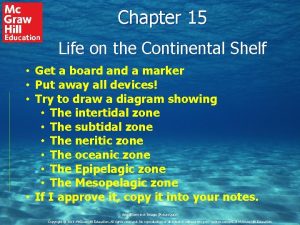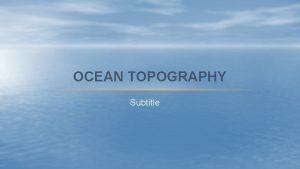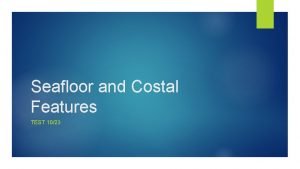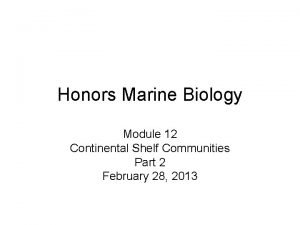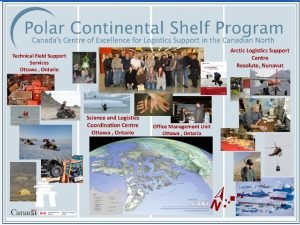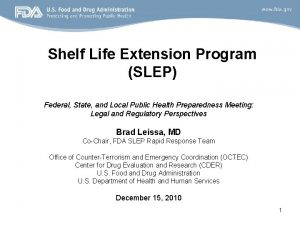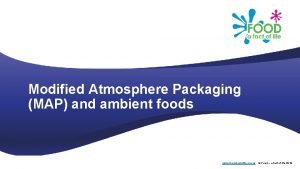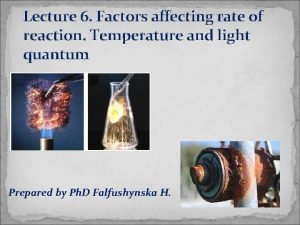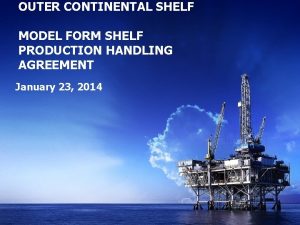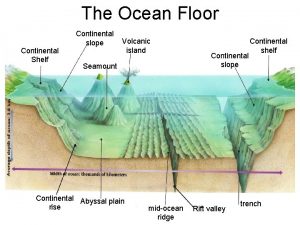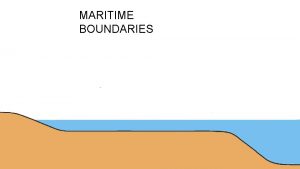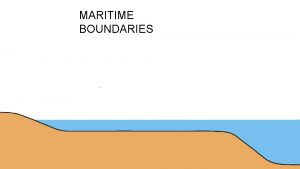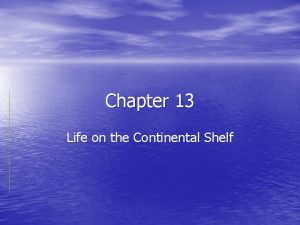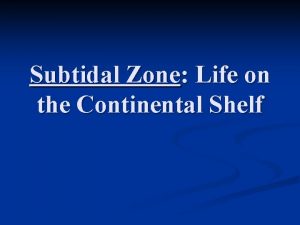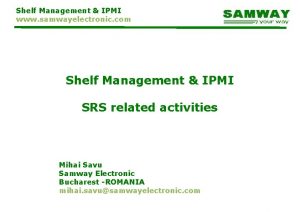Chapter 15 Life on the Continental Shelf Get


















- Slides: 18

Chapter 15 Life on the Continental Shelf • Get a board and a marker • Put away all devices! • Try to draw a diagram showing • The intertidal zone • The subtidal zone • The neritic zone • The oceanic zone • The Epipelagic zone • The Mesopelagic zone • If I approve it, copy it into your notes. (bkgd)Comstock Images/Picture. Quest Copyright © 2016 Mc. Graw-Hill Education. All rights reserved. No reproduction or distribution without the prior written consent of Mc. Graw-Hill Education.

The Continental Shelf • Biologically, the richest part of the ocean, – includes a major portion of commercial fisheries. • also other natural resources – oil and natural gas – International conflict • Being close to shore, is affected by pollution and other human …………. . activities. (bkgd)Comstock Images/Picture. Quest

The Continental Shelf • It extends from • • the low tide level on shore to the shelf break, or the edge of the continental shelf. Includes the Subtidal Zone and the Neritic zone. Are usually much wider on passive margins than on active margins. (bkgd)Comstock Images/Picture. Quest

Continental Shelf - Physical Characteristics • Temperature of the water varies much more • than the water in the deep sea but less than in an estuary or on rocky shores. Turbulence from waves and surface currents keep the water column well mixed, with generally no stratification. (bkgd)Comstock Images/Picture. Quest

Continental Shelf Physical Characteristics • Sedimentation – Water motion sorts out particles by size and density. – Large-grained material like gravel and settles out even in areas with strong waves and currents, but fine particles like silt and clay are kept in suspension. – Suspension and Phytoplankton decreases transparency (bkgd)Comstock Images/Picture. Quest

Continental Shelf (Subtidal) Communities 1. 2. 3. 4. Soft-bottom subtidal Seagrass meadows Hard-bottom subtidal Kelp Forests (bkgd)Comstock Images/Picture. Quest

Soft Bottom Subtidal Communities • Have infauna, epifauna, and meiofauna (bkgd)Comstock Images/Picture. Quest

Soft Bottom Subtidal Communities – Sessile species are rare – Very few primary producers (seaweeds, plants) but some benthic diatoms living on sediment particles – Infauna (many tube-dwelling and digging species: polychaetes, molluscs, etc. ) and epifauna (sea stars, brittle stars, sea pens, etc. ) – Demersal (bottom-dwelling) fishes (bkgd)Comstock Images/Picture. Quest

Soft Bottom Subtidal Communities • Soft-bottom benthos – Bioturbators disturb bottom sediments and help in oxygenation (bkgd)Comstock Images/Picture. Quest

Seagrass Meadows • Seagrasses – flowering plants – Develop in sheltered, shallow waters with good water clarity and mostly soft sediments – High Biodiversity – Excellent Habitat (bkgd)Comstock Images/Picture. Quest

Seagrass Meadows • The density of individual • • • plants tends to be high: high biomass. High primary production Some herbivores feed on the leaves but most of the “food” is detritus. Help stabilize sediments (bkgd)Comstock Images/Picture. Quest, (r)Getty Images/i. Stockphoto

Seagrass Meadows – Generalized Food Web (bkgd)Comstock Images/Picture. Quest

Hard-Bottom Subtidal Communities • Hard-bottom Subtidal Communities – Less common – Dominated by epifauna and seaweeds in shallow water – Seaweeds must compete for attachment surfaces with each other, as well as sessile animals.

Hard-Bottom Subtidal Communities - Sea urchins are important in influencing the composition of communities. - They graze on seaweeds and on some of the encrusting animals and uncover new surfaces where other sessile organisms can settle. (bkgd)Comstock Images/Picture. Quest, (r)©Charlie Arneson

Hard-Bottom Subtidal Community – Generalized Food Web (bkgd)Comstock Images/Picture. Quest

Kelp Communities • Kelp Communities – brown seaweeds restricted to cold water – Develop only on rocky bottoms, in water as deep as light allows – Fast growing, may form a floating canopy. – High primary production (bkgd)Comstock Images/Picture. Quest

Kelp Distribution (bkgd)Comstock Images/Picture. Quest

Giant Kelp Forests (bkgd)Comstock Images/Picture. Quest
 Get on / get off transport
Get on / get off transport Continental shelf definition
Continental shelf definition Continental shelf picture
Continental shelf picture Naamaari
Naamaari Continental shelf
Continental shelf Continental shelf
Continental shelf Polar continental shelf program
Polar continental shelf program Songs with literary devices
Songs with literary devices Plate boundaries types
Plate boundaries types Oceanic oceanic convergent boundaries
Oceanic oceanic convergent boundaries Cyanokit shelf life
Cyanokit shelf life Shelf life extension program
Shelf life extension program Salt cured meat shelf life
Salt cured meat shelf life Accelerated shelf life testing calculator
Accelerated shelf life testing calculator Salt cured meat shelf life
Salt cured meat shelf life Rate limiting steps in drug absorption
Rate limiting steps in drug absorption Shelf life formula
Shelf life formula Shelf life formula
Shelf life formula Get up get moving quiz
Get up get moving quiz


